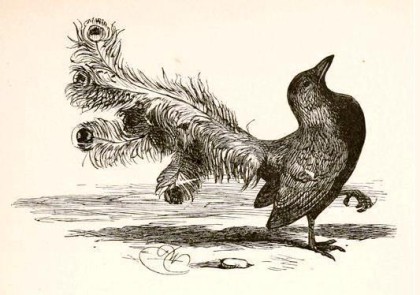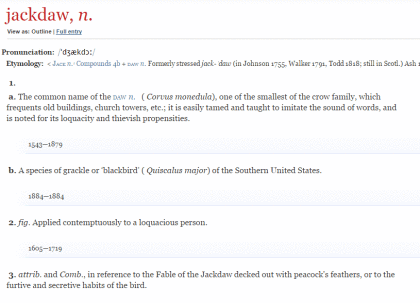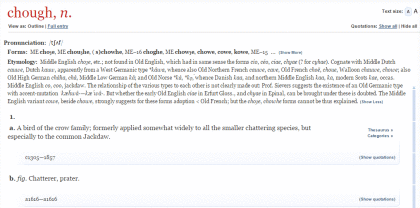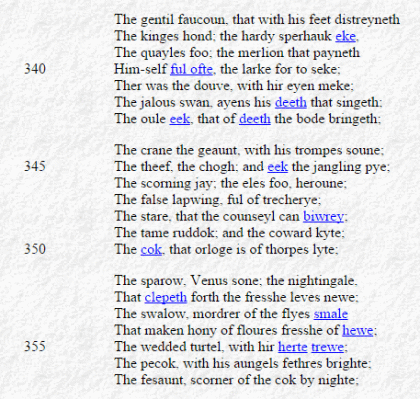Category — The Jackdaw Series
As the Crow Flies
The Festival Robe is back, and it’s time to have some fun! We’re going to fly about the literature, following the path of a certain black bird as it alights on literature from Æsop to Jonson and points in between.
We begin with the famous pamphlet, Greene’s Groatsworth of Wit, noteworthy in that some believe its reference to Shake scene is the first reference to William Shakespeare in literature. The paragraph in question that has drawn so much scrutiny over the years is as follows.
“Yes, trust them not, for there is an upstart crow, beautified with our feathers, that, with his Tygers heart wrapt in a Players hide, supposes he is as well able to bumbast out a blanke verse as the best of you; and being an absolute Johannes Factotum, is in his owne conceit the onely Shake-scene in a countrie.“
I intend to look at the question as to whether or not this fellow “Shake-scene” is Will Shaksper, and with attention to the other bolded words above, the crow beautified with our feathers, and Johannes Factotum.
On the topic of Joannes Factotum, Rambler has investigated it here and elsewhere. He has other posts on Groatsworth, but that particular post is worth reading before proceeding here. His idea that Johannes somehow relates to Vere’s father being named John makes sense. Now some information new to me fits as a possible linkage. As part of the vast topic of heraldry, noble families had ‘badges’ – symbols that often were visual puns on their names. An example of one badge is a glass bottle for the Vere family. The french word for glass is “verre,” the bottle is visual pun. The Vere’s also had a badge that was is described in places as a “cranket,” A jack type device for raising and lowering pots over fires. This badge was adopted by the Vere’s at time of the 16th Earl, John de Vere. It’s a pun on his name – “Jack.” If this badge was worn on the livery coats of Oxford’s retainers, it could explain the many references to “Jack” we’ve encountered along the way here at The Festival Robe. I’ll be surveying those references below. Now a “Jack” is also a term for a common man, or a knave, and there may be no connection. I’m not offering proof. But the Jack livery badge may be the connection between the name John, as applied to Edward de Vere’s father and Johannes Factotum, as Rambler has speculated as possible.
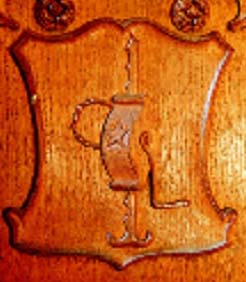
“Jack” livery badge
The link to Rambler above contains a pretty good evisceration of the Hoster’s theory that Shake-scene stood for the actor, Edward Allyn. But I’d like to take Hoster apart further, as his idea seems to have a curious life-span among both Oxfordians and Stratfordians. I believe the attraction to Hoster is based on a begging the question fallacy. Hoster’s theory is a reach, but he wants to believe it so, because Groatsworth implies that Shake-speare is a theif who has purloined the “feathers” of others. Since Stratfordians want so badly to believe in their man’s genius, Groatsworth must be talking about someone else. Oxfordians have falllen into the same trap. So many of them badly want to believe that Shaksper was not an actor, had little to do with the theater, and was generally a moron, ergo Groatsworth can’t be talking about him. These Oxfordians have gladly latched on to the Shake-scene as Allyn idea, no matter how weak that argument is.
I’d like to point out another problem with Hoster’s argument, above and beyond Rambler’s excellent criticism. Hoster contends the crow’s use of the feathers is simply indicative of an actor’s use of a playwright’s work. Well of course, actors always use the work of playwrights. This approach to Groatsworth flies in the face of the literary origins of the crow using another feather’s. That origin goes back to Æsop’s fables. To understand the Groatsworth reference, you have to know the fable. The crow is not simply any type of crow, it’s a specific species, the jackdaw. Here’s the fable.
The Vain Jackdaw
“Jupiter announced that he intended to appoint a king over the birds, and named a day on which they were to appear before his throne, when he would select the most beautiful of them all to be their ruler. Wishing to look their best on the occasion they repaired to the banks of a stream, where they busied themselves in washing and preening their feathers. The Jackdaw was there along with the rest, and realised that, with his ugly plumage, he would have no chance of being chosen as he was: so he waited till they were all gone, and then picked up the most gaudy of the feathers they had dropped, and fastened them about his own body, with the result that he looked gayer than any of them. When the appointed day came, the birds assembled before Jupiter’s throne; and, after passing them in review, he was about to make the Jackdaw king, when all the rest set upon the king-elect, stripped him of his borrowed plumes, and exposed him for the Jackdaw that he was.”
Translated by V. S. Vernon Jones 1912
A Jackdaw with borrowed plumes. (1881)
Let’s look at the OED definition of jackdaw.
There are three properties of the jackdaw I’d like to focus on.
- It’s a thief.
- It’s a mimic.
- It is small.
Note that it is the jackdaw-as-thief and mimic characteristics upon which the fable is constructed. he takes the other bird’s feathers, and then he mimics them. Hoster’s Allyn interpretation strips that meaning completely from Groatsworth.
The jackdaw makes another early appearance in English literature – in the fable of The Parliament of Birds. Chaucer retells that fable. Chaucer uses an alternate name for the jackdaw, “chough.”
Here’s the OED for chough.
click to enlarge
And Chaucer’s use, describing the bird as a thief, line 345.
click to enlarge
Now, with our information gathered, we can move forward into the literature of the jackdaw. Readers of The Festival Robe likely know where we first alight, on Ben Jonson’s play Epicene of 1609, which features a character named Jack Daw. We’ve discussed him before, here and here. Those posts are worth revisiting before we proceed. I’ll be back with more on Sir Daw soon enough, as we follow the jackdaw’s flight path across the Jacobethan dramatic landscape.
more anon.
February 24, 2015 No Comments

